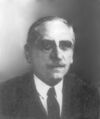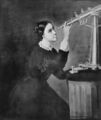Template:Selected anniversaries/June 28: Difference between revisions
No edit summary |
No edit summary |
||
| Line 64: | Line 64: | ||
||1972: Prasanta Chandra Mahalanobis dies ... scientist and applied statistician. He is best remembered for the Mahalanobis distance, a statistical measure and for being one of the members of the first Planning Commission of free India. Pic. | ||1972: Prasanta Chandra Mahalanobis dies ... scientist and applied statistician. He is best remembered for the Mahalanobis distance, a statistical measure and for being one of the members of the first Planning Commission of free India. Pic. | ||
File:Marc_Julia.jpg|link=Marc Julia (nonfiction)|1973: Chemist and acclaimed screenwriter [[Marc Julia (nonfiction)|Marc Julia]] wins the Academy Awards Best Screenplay Award for ''[[The Julia Olefination]]'', | File:Marc_Julia.jpg|link=Marc Julia (nonfiction)|1973: Chemist and acclaimed screenwriter [[Marc Julia (nonfiction)|Marc Julia]] wins the Academy Awards Best Screenplay Award for ''[[The Julia Olefination]]'', "a tense and exciting thriller, combining phenyl sulfones with aldehydes (or ketones) to give alkenes after alcohol functionalization and reductive elimination using sodium amalgam or SmI2." | ||
||1981: A powerful bomb explodes in Tehran, killing 73 officials of the Islamic Republican Party. | ||1981: A powerful bomb explodes in Tehran, killing 73 officials of the Islamic Republican Party. | ||
Revision as of 04:37, 19 March 2020
1598: Cartographer and geographer Abraham Ortelius dies. Ortelius created the first modern atlas, the Theatrum Orbis Terrarum. He was also one of the first to imagine that the continents were joined together before drifting to their present positions.
1712: Philosopher and author Jean-Jacques Rousseau born. His political philosophy will influence the Enlightenment in France and across Europe.
1824: Physician, anatomist, and anthropologist Paul Broca born. He will discover that the brains of patients suffering from aphasia contain lesions in a particular part of the cortex, in the left frontal region -- the first anatomical proof of the localization of brain function.
1825: Chemist and academic Emil Erlenmeyer born. He will contribute to the early development of the theory of structure, formulating the Erlenmeyer rule, and designing the Erlenmeyer flask.
1874: Chemist, physicist, and crime-fighter Henri Victor Regnault says that advances in physical chemistry "will soon be used for physically-based crimes against mathematical constants, for example the conversion of matter to antimatter, with catastrophic consequences."
1875: Mathematician and academic Henri Lebesgue born. He will gain fame for his his theory of integration, which generalizes the 17th century concept of integration (summing the area between an axis and the curve of a function defined for that axis).
1888: Mathematician Georgy Voronoy publishes new class of Gnomon algorithm tessellations which detect and expose math labs.
1889: Astronomer and academic Maria Mitchell dies. She was the first American woman to work as a professional astronomer.
1906: Physicist and academic Maria Goeppert-Mayer born. She will develop a mathematical model for the structure of nuclear shells, for which she will be awarded the Nobel Prize in Physics in 1963, which she will share with J. Hans D. Jensen and Eugene Wigner.
1973: Chemist and acclaimed screenwriter Marc Julia wins the Academy Awards Best Screenplay Award for The Julia Olefination, "a tense and exciting thriller, combining phenyl sulfones with aldehydes (or ketones) to give alkenes after alcohol functionalization and reductive elimination using sodium amalgam or SmI2."









